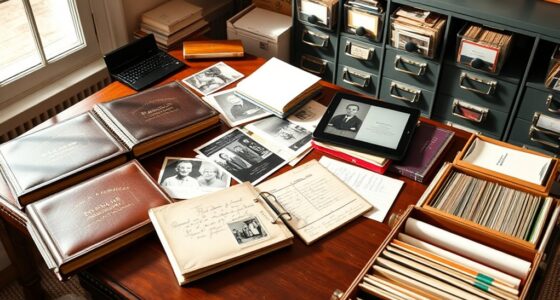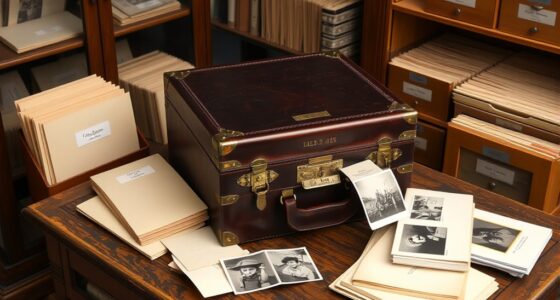To archive historical documents at home, store them in acid-free folders and boxes in a cool, dry, and dark environment to prevent deterioration. Handle items carefully with gloves or clean hands, and avoid folding or bending fragile pieces. Consider digitizing your collection with high-resolution scans for easier access and backup. Regularly inspect for damage or pests and maintain stable conditions to slow decay. Keep exploring for more tips to preserve your treasured documents effectively.
Key Takeaways
- Store documents in acid-free folders and boxes in a cool, dry, and dark environment to prevent deterioration.
- Handle documents with clean hands or gloves and minimize physical contact to reduce damage.
- Digitize documents using high-resolution scanners and organize images with clear labels for easy access.
- Regularly inspect stored items for signs of mold, pests, or fading, and address issues promptly.
- Maintain stable temperature and humidity levels, and avoid folding or bending fragile items during storage.

Have you ever wondered how we preserve the past for future generations? The answer lies in effective archiving techniques that protect fragile documents and guarantee they remain accessible over time. When you’re archiving historical documents at home, understanding preservation techniques is essential. These methods help prevent deterioration caused by light, humidity, and handling, keeping your collection intact for years to come. You might start by choosing a suitable storage environment—cool, dry, and away from direct sunlight. Acid-free folders and boxes are crucial, as they prevent the paper from yellowing or becoming brittle. Handling documents with clean hands or gloves also minimizes oils and dirt that can cause damage. It’s important to keep documents flat and avoid unnecessary folding or bending, which can weaken the paper. Regularly updating your inventory and maintaining detailed records also help in tracking your collection’s condition and provenance. Digital cataloging plays a crucial role in modern archiving, especially for home collectors. By creating a digital record of your documents, you make it easier to organize, search, and share your collection without handling the original items repeatedly. This process involves scanning each document with a high-resolution scanner and saving the images in a structured digital folder system. When you assign clear labels—such as dates, titles, or provenance details—you streamline future retrieval and reduce the risk of misplacing or mishandling the originals. Digital cataloging also provides a backup in case of physical damage or loss. Cloud storage options or external drives ensure that your digital records are safe and accessible from multiple devices. Another key aspect of preservation at home is regular maintenance. Periodically inspecting your collection for signs of deterioration helps catch problems early. Look out for fading ink, mold, or pests, and address issues promptly. Keep your storage environment stable, avoiding extreme temperature fluctuations or high humidity, which can accelerate decay. If you notice any damage, consulting professional conservators might be necessary, but many minor issues can be managed with proper handling and storage. Additionally, maintaining an organized system, whether physical or digital, saves time and reduces stress when locating specific documents.
Frequently Asked Questions
What Are the Best Materials for Homemade Document Storage?
When choosing materials for homemade document storage, you want to prioritize acid-free paper and archival quality storage options. These materials help protect your documents from deterioration over time. Use acid-free folders, boxes, and sleeves to guarantee longevity. Avoid regular paper or plastic that contains acids, as they can damage your documents. By selecting the right materials, you preserve your valuable papers safely and maintain their condition for years to come.
How Can I Prevent Mold and Mildew on Old Papers?
To prevent mold and mildew on old papers, you should follow conservation techniques that keep your documents dry and well-ventilated. Store them in archival supplies like acid-free folders and boxes, which help control humidity and protect against moisture. Keep your storage area cool and consistent in temperature, avoid damp environments, and consider using silica gel packets to absorb excess moisture. Regularly check your collection for early signs of mold.
What Temperature and Humidity Levels Are Ideal for Archiving?
A stitch in time saves nine, and maintaining proper climate control helps preserve your documents. Keep your storage area at about 65-70°F (18-21°C) and 40-50% humidity to prevent deterioration. Use environmental monitoring tools to stay on top of conditions. Consistent temperature and humidity levels create a stable environment, reducing mold, mildew, and other damage, ensuring your cherished items stay safe for years to come.
How Do I Safely Handle Fragile or Brittle Documents?
When handling fragile or brittle documents, you should always wear handling gloves to prevent oils and dirt from damaging them. Use proper tools like tweezers or spatulas to carefully lift and move these items. Handle the documents gently, supporting their entire surface, and avoid using excessive force. Keep your workspace clean and flat to prevent tearing or further deterioration, ensuring you preserve the integrity of the documents.
Are Digital Backups Recommended Alongside Physical Archiving?
Did you know over 80% of historical documents are now digitized? Digital preservation is highly recommended alongside physical archiving because it offers a secure backup, reducing the risk of loss due to damage or theft. Cloud storage makes it easy to access your documents from anywhere, ensuring your collection stays safe and intact. Combining both methods provides an all-encompassing approach to preserving your valuable historical records effectively.
Conclusion
Now that you know how to archive your historical documents at home, you’re preserving a piece of history for future generations. Did you know that over 90% of historical documents are at risk of deterioration within 100 years if not properly stored? By taking simple steps like using acid-free materials and controlling humidity, you’re safeguarding your family’s stories and valuable history. Start today, and your efforts will guarantee these memories last for decades to come.









